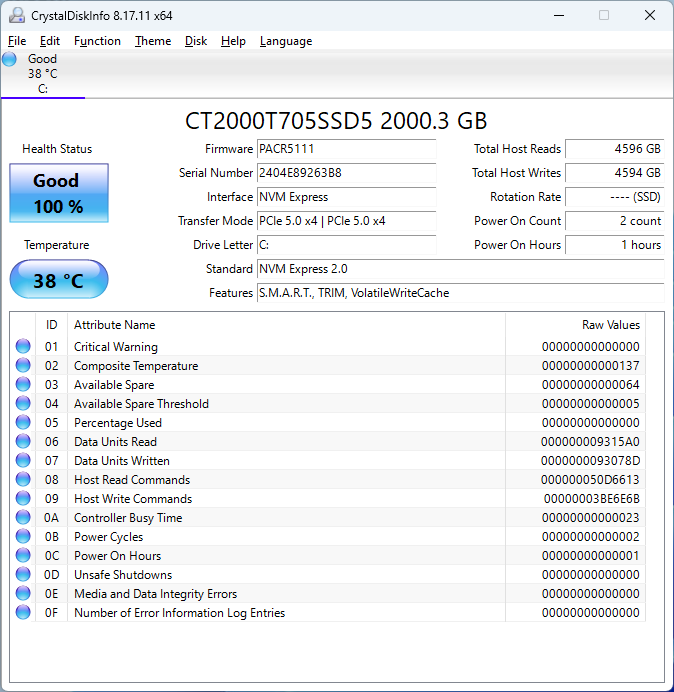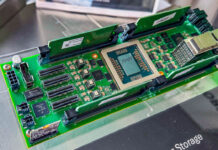Today, we are looking at the Crucial T705 2TB PCIe Gen5 NVMe SSD. We have recently covered both Crucial’s T700 drive, their previous flagship Gen5 offering, and the T500, their current high-performance Gen4 offering. The T705 represents Crucial’s entry into a new wave of Gen 5 SSDs that can push against the 14 GB/s interface limits of a PCIe Gen 5 x4 PCIe link. This is the first 14 GB/s drive I have had the opportunity to test, so I am excited to see what it can do.
Crucial T705 2TB SSD
The Crucial T705 2TB comes in a double-sided M.2 2280 (80mm) form factor, and it is available both with and without a heatsink.

The T705 comes equipped with a Phison PS5026-E26 controller. This is the same controller seen on the T700, the FireCuda 540, and several other Gen 5 drives. Paired with the E26 controller is 232-layer Micron TLC NAND and a LPDDR4 DRAM cache. This is not particularly different from the T700, despite the gap in their rated specs.

One note: my testing sample of the T705 came with a substantial heatsink attached. Unfortunately, this is the variety of heatsink that is not designed to be user-removable, similar to WD’s SN850 line. While it might be possible to remove the heatsink, it would involve bending metal and likely would not be easy to reassemble. Since this was the only test sample that Micron sent for the embargo date review, I elected not to risk damaging mine. I always prefer when bundled heatsinks are easily removable. Even if you need the heatsink today, you might reuse this drive in a situation where the heatsink is no longer needed or does not fit. An example is an installation into a PS5, then a motherboard or NAS with an integrated M.2 heatsink system. Of course, that is not going to be everyone, but it just helps components get reused.

As a double-sided drive, the back of the T705 is home to half the NAND. It is under there, I promise.
Crucial T705 SSD Specs
The Crucial T705 comes in capacities between 1TB and 4TB.

Now, we come to the important bits. The 2TB model of the T705 is rated at 14500 MB/s sequential read, and 12700 MB/s sequential write. The read speed, in particular, is right at the limits of what a PCIe Gen 5 x4 link can sustain. Endurance is rated at 1200 TBW, which is what I expect to see on a 2TB drive. The T705 will also come with the industry standard 5-year warranty. All of the basics check out on this drive, so I am excited to see it perform in testing.

CrystalDiskInfo can give us some basic information about the SSD and confirms we are operating at PCIe 5.0 x4 speeds using NVMe 2.0.
Test System Configuration
We are using the following configuration for this test:
- Motherboard: MSI MAG X670E Tomahawk
- CPU: AMD Ryzen 9 7900X (12C/24T)
- RAM: 2x 16GB DDR5-6000 UDIMMs
Our testing uses the Crucial T705 2TB as the boot drive for the system, installed in the M.2_1 slot on the motherboard. This slot supports up to PCIe Gen 5 x4. The drive is filled to 85% capacity with data, and then some is deleted, leaving around 60% used space on the volume.
Next, we are going to get into our performance testing.





Does anyone have any specs comparing the T700/705/other Gen5 NVMe to options like Intel Optane 905P. I’d love to see some comparison for real-world groups like productivity, gaming, and server use.
It seems like a balancing act to find the best throughput and latency combo. I don’t really have a need for high speed storage in work environment, but my home workloads might.
So, here we have another benchmark optimized drive… that shows very poor 512/4K read performance…
These benchmark optimized drives generally attain these sequential speeds for only a few gigabytes before they fall off rapidly.
Looking at these numbers, this drive when written from start to finish probably does 250Mbps on average or even less…
So is this really a 10Gbps drive? No, stop using 8Gb benchmarks and write an actually dataset to the entire drive!
Sjoer van der Ploeg,
You must have missed the part where I wrote 85% of the drive from start to finish and the drive held 3 GB/s+ the entire time. That’s a fair bit better than your ‘probably does 250Mbps on average or even less’
What is the claimed active power, when interrogated using nvme utils? I’d love to know if this heatsink makes any sense.
I general it would be awesome if the SSD reviews could include a readout of all the relevant NVMe parameters like power states, LBA format, etc.
U suppose these speeds will be the norm in a few years and yeah I wwouldn’t say no to the 4TB as my X670E-I ITX board does support it. But wow those prices!